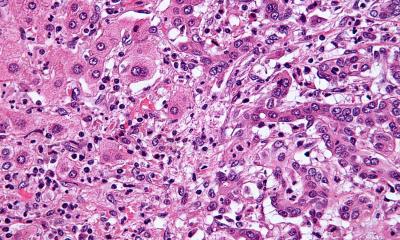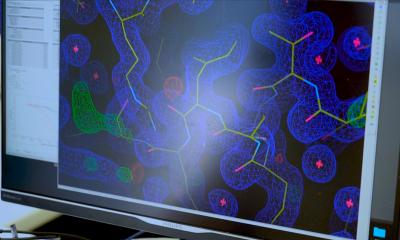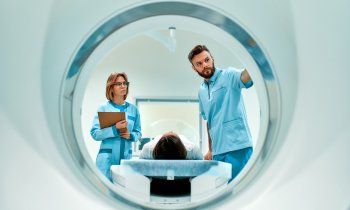Frostbite
Chilled to the bone!
For people living in Chamonix-Mont Blanc medical services at the nearby community hospital have been reduced to little more than a stopover visit before being referred down the mountain to larger facilities in the network of the Hospitals of Mont Blanc Country.
Report: John Brosky


Yet the small facility continues to hold a specialty for treating frostbite victims that is unique in the world and puts it at the centre of a European-funded study to test a new technique for treating victims of severe frostbite who are in danger of losing fingers, toes or even all of a foot. The hospital holds the distinction of each year seeing the highest number of cases of frostbite in the world, not only in full winter, but in summer as well.
With this steady flow of frost bitten hikers and skiers, Emmanuel Cauchy MD, is in a unique position at the Centre for Training and Research in Mountain Medicine (IFREMMONT) that is housed at the hospital to study the effects of the condition, to conduct randomised trials for therapies, and to publish findings that advance protocols for treatment.
His 2011 paper updating and detailing a classification of frostbite in four distinct stages is a landmark reference. ‘There are more and more cases of frostbite in the largest cities, with the number of homeless people, very bad cases, but there isn’t always a good awareness of the proper treatment,’ Cauchy said during our visit to IFREMMONT. ‘Where some physicians may see one case of frostbite each year, or perhaps one severe case in all of their career, we see between 80 and 100 such cases every year – an average that goes back over the past 20 years.’
The reason for the exceptional traffic of frostbite cases in Chamonix stands just outside the hospital door. Towering at 15,780 feet, Mont Blanc is not only the highest point in Europe, it is also the deadliest mountain in the Western world with an average of 100 trekkers perishing somewhere up there each year.
Mont Blanc is reputed to be the most accessible summit in the world, which explains why more than 20,000 mountaineers, often 500 on a single day, can be found marching in Indian file to the top. Reaching the roof of Europe from the French side is described as more of a long walk that an arduous alpine climb. It is easy to forget the local wisdom that it is always winter up there among the glaciers and multiple peaks surrounding the massif of Mont Blanc.
Three-fourths of frostbite cases arriving at the Mountain Medicine centre are superficial, Cauchy pointed out, and even the frostbitten hiker or skier doesn’t realise until the following day that some extremity has gone numb, and they turn up at the clinic. One-in-four people have been bitten more deeply by glacial cold, more than half with frozen feet. Hands are almost as frequent and while facial frostbite is more rare, some 17% of cases he sees touch noses and ears. On average one in 12 patients will need an amputation.
‘Often you see the tissue is red and you think you’re going to be alright,’ Cauchy said. But after a scintigraph scan that shows there is no vascularization of the bone ‘…it’s finished in this case, there is nothing we can do.’ Restoring blood flow to the bone tissue of frost-bitten fingers and toes is the critical factor for averting an amputation of the member and encouraging such reperfusion in a hyperbaric chamber is at the heart of a clinical study begun at this alpine hospital in November 2014.
Hyperbaric oxygen therapy has been suggested as a treatment for severe frostbite that may help lower the rate of amputation by more rapidly increasing blood circulation in the bone, but the technique lacks any clinical evidence to support wider use.
For the GELOX study, the Chamonix Hospital is working in close collaboration with the University Hospital of Geneva to test the treatment of 20 patients and compare results with outcomes for 50 patients who underwent standard protocols.
The hyperbaric chamber is located at the University Hospital of Geneva, a sealed room where the pressure can be increase as high as 2.5 times normal atmospheric pressure. Most large hospitals have such chambers, Cauchy said, typically for treating patients with difficult wounds.
He also points out that portable, inflatable chambers are routinely carried as essential equipment for the base camp of climbing expeditions to treat or prevent acute altitude illness. Using a mechanical pump, atmospheric pressure is increased inside the chamber to increase the victim’s arterial oxygen pressure, thereby reproducing the effects of a low-altitude evacuation when a real descent is not possible.
Patients enrolled in the study will be hospitalised in Chamonix for up to eight days to undergo specific therapies developed by Cauchy at IFREMMONT. Each day the patient will be transported to Geneva, an hour away, for a treatment session in a large-scale, 16-person hyperbaric chamber where atmospheric pressure is increased to 1.5 bars.
Oxygen levels will also be boosted during the hyperbaric session, Cauchy explained, to increase the oxygen transport capacity of the plasma to counteract ischemia in tissue. Frostbite patients also suffer from painful wounds and, as with other patients being treated in the hyperbaric chamber, the therapy sessions are also expected to improve wound healing.
The cross-border cooperation for the GELOX study is supported by funding of €421,000, half of which is provided by the European Regional Development Fund with the remaining financing raised jointly by French and Swiss regional authorities.
23.03.2015











